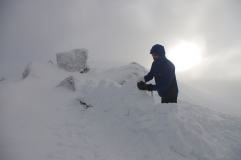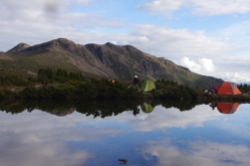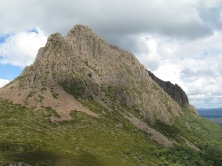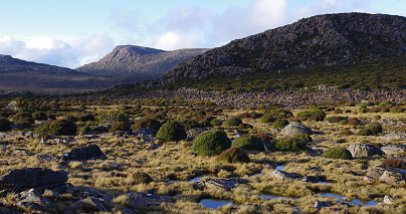Leading scientists working across Australia and Antarctica have described 19 ecosystems that are collapsing due to the impact of humans and warned urgent action is required to prevent their complete loss.
A groundbreaking report – the result of work by 38 scientists from 29 universities and government agencies – details the degradation of coral reefs, arid outback deserts, tropical savanna, the waterways of the Murray-Darling Basin, mangroves in the Gulf of Carpentaria, and forests stretching from the rainforests of the far north to Gondwana-era conifers in Tasmania.
The scientists recommended a new framework to try to prevent ecosystems collapsing completely that they called the “3As”. It would require a greater awareness of the value of ecosystems, better planning to anticipate risks and rapid action to reduce them.
The report is titled Combating ecosystem collapse from the tropics to the Antarctic.
What does this mean for mountain environments?
According to reporting by Adam Morton in The Guardian,
The study’s lead author, Dr Dana Bergstrom from the Australian Antarctic Division, said 19 out of 20 ecosystems examined were experiencing potentially irreversible environmental changes, including the loss of species and the ability to perform important functions such as pollination.
The authors say:
This is a dire wake-up call — not just a warning. Put bluntly, current changes across the continent, and their potential outcomes, pose an existential threat to our survival, and other life we share environments with.
The following is taken from an article in The Conversation by several of the report authors.
Montane and sub alpine forests
 Montane alpine ash and subalpine snowgum forests occupy the highest forested areas of the Australian Alps. Alpine ash are giants and can grow over 90 metres tall, although trees over 40m are rare across most of the alps today.
Montane alpine ash and subalpine snowgum forests occupy the highest forested areas of the Australian Alps. Alpine ash are giants and can grow over 90 metres tall, although trees over 40m are rare across most of the alps today.
Intense fires kill both snowgums and alpine ash. Climate change is increasing the frequency of fire through droughts, longer snow-free periods, tree stress and dry lightning in storms. This is amplified by positive feedback, where regrowth after prescribed burns or bushfire is much more flammable than long-unburnt forest. From 2000 to 2019, 84% of the entire alpine ash forests in NSW and Victoria were burned, some areas up to three times. Now, 70% of alpine ash are immature trees and over 75% of snow gums are at their most flammable age.
These forests are critical to the health of one of Australia’s most important water catchments. They also store large quantities of carbon, and surround high value utility and tourism infrastructure, such as Snowy Mountain power stations and ski resorts.
Increases in wildfire amplified by positive feedbacks place a heavy economic burden on these, as well as a health and safety impact on surrounding human populations.
Pressures:
Rainfall changes
Temperature
Heatwave
Storm
Fire
Habitat change/loss
Invasive species
Livestock / harvesting
Human-lit fire
Monaro Tablelands
The Monaro tablelands of south-east NSW are characterised by mosaics of grassy woodlands, grasslands and forests. These provide important habitat for a range of threatened plants and animal species, including koalas, spotted-tail quolls and dusky wood swallows, as well as 15 other smaller marsupial species, 95 bird species, 14 species of reptiles and more.
Like most other temperate grasslands and grassy woodlands in Australia, the Monaro ecosystems have declined since Indigenous burning regimes were replaced with livestock and feral herbivore grazing, along with clearing, cultivation and non-native plant invasions.
Tragically, since 2005, ribbon gums that once dominated the rolling plains have died in great numbers. This is likely associated with the Millennium drought, ongoing drying conditions and heatwaves, and exacerbated by invertebrate pest outbreaks. More recently, the catastrophic Black Summer bushfires burned extensive areas across the Monaro.
Widespread tree deaths are not only a loss of habitat for mammals, birds, reptiles and invertebrates, but significantly impact the economy through lack of shelter for livestock during the Monaro’s harsh winters and hot summers. The impacts on the landscape’s aesthetic also affects human well-being.
Pressures:
- Rainfall changes
- Temperature
- Native species interactions
- Heatwave
- Fire
- Habitat change/loss
- Invasive species
- Livestock/harvesting
Snowpatch Herbfields
 The snowpatch herbfields, made up of dwarf grasses and alpine herbs, are one of the rarest and most restricted ecosystems in Australia. They occur only on steep, south-east-facing slopes of alpine and high treeless subalpine zones, where snow persists into the spring and summer growing seasons.
The snowpatch herbfields, made up of dwarf grasses and alpine herbs, are one of the rarest and most restricted ecosystems in Australia. They occur only on steep, south-east-facing slopes of alpine and high treeless subalpine zones, where snow persists into the spring and summer growing seasons.
Over the past 50 years, climate change has caused warming of almost 1°C, and substantial decrease in snow amount and depth, cover and persistence in the Australian alpine area. Fire has also become a major force with increased frequency, dry lightning storms and extreme fire weather. And feral horses trample vegetation and cause soil erosion. These pressures, and others, are collapsing the snow patch herbfield, replacing them with larger shrubs and grasses or just eroded ground.
The collapse of the snow patch herbfields highlights the plight of the Australian alpine ecosystems in general. The alps are regional economic powerhouses; visitors to the Australian Alps generate over A$1.3 billion and the area employs almost 20,000 people.
Pressures:
Rainfall changes
Temperature
Storm
Fire
Habitat change/loss
Invasive species
Human-lit fire
Mountain Ash forests
 The mountain ash ecosystem in the Central Highlands of Victoria supports the world’s tallest flowering plants. It’s among the world’s most carbon-dense forests, supporting an array of threatened forest-dependent species, and generating almost all of the water for the 5 million inhabitants of Melbourne (as well as communities and agriculturalists north of the Great Divide).
The mountain ash ecosystem in the Central Highlands of Victoria supports the world’s tallest flowering plants. It’s among the world’s most carbon-dense forests, supporting an array of threatened forest-dependent species, and generating almost all of the water for the 5 million inhabitants of Melbourne (as well as communities and agriculturalists north of the Great Divide).
The mountain ash ecosystem is under enormous environmental pressure from widespread and recurrent wildfire, coupled with widespread clear-cut logging. Extensive old growth forests once dominated the ecosystem, but now just 1.16% of the ecosystem (1,886 hectares of 170,400 ha) is old growth. The widespread young forest is highly flammable and at extreme risk of reburning at high severity. This is especially due to increased temperatures and greater numbers of days marked as “extreme” on the forest fire danger index.
The collapse will have severe economic and social effects. The value of water from the ecosystem is 25.5 times greater than the value of the timber generated from the same ecosystem. The collapse of the ecosystem also poses an enormous threat for long-term carbon storage, biodiversity conservation and the billion-dollar tourism industry in regional Victoria.
Pressures:
Rainfall changes
Temperature
Fire
Habitat change/loss
Invasive species
Other
Gondwanan conifer forests, Lutruwita/ TAS
 The Tasmanian Wilderness World Heritage Area covers 15,800 square kilometres. One of its key values is the high concentration of ancient invertebrate animals and plants endemic to Tasmania (often called “palaeoendemics”). An iconic example is the genus Athrotaxis in the conifer family, which is considered one of the oldest surviving plant lineages on Earth — a living fossil.
The Tasmanian Wilderness World Heritage Area covers 15,800 square kilometres. One of its key values is the high concentration of ancient invertebrate animals and plants endemic to Tasmania (often called “palaeoendemics”). An iconic example is the genus Athrotaxis in the conifer family, which is considered one of the oldest surviving plant lineages on Earth — a living fossil.
There are two existing species of Athrotaxis: Pencil pines (Athrotaxis cupressoides) and king billy pines (Athrotaxi selaginoides). Both are very slow growing and can live for more than 1,000 years.
Like other palaeoendemics, Athrotaxis species can’t tolerate frequent or intense fire, and are restricted to fireproof landscapes. Around 30% of the range of king billy pines have been lost in the last 200 years, and half the pencil pines were burnt in the summer of 1960/61 by uncontrolled fires set by graziers to renew grasslands during an intense drought.
Climate change now threatens these and other palaeoendemic species through increased fire activity due to more dry lightning storms and drought. In January 2016, lightning storms ignited numerous fires that destroyed about 1% of the remaining pencil pines. These trees are unlikely to ever return. The loss of palaeo-endemics will profoundly diminish the region’s natural and cultural values.
Securing the survival of palaeoendemics under climate change requires costly management interventions. These include establishing fire breaks, targeted planned burning to reduce fuel surrounding the palaeoendemic refuges and active restoration programs. The Tasmanian Government and the University of Tasmania currently trial these measures.
Pressures:
Rainfall changes
Temperature
Storm
Fire
Habitat change/loss
Invasive species
























































Leave a comment